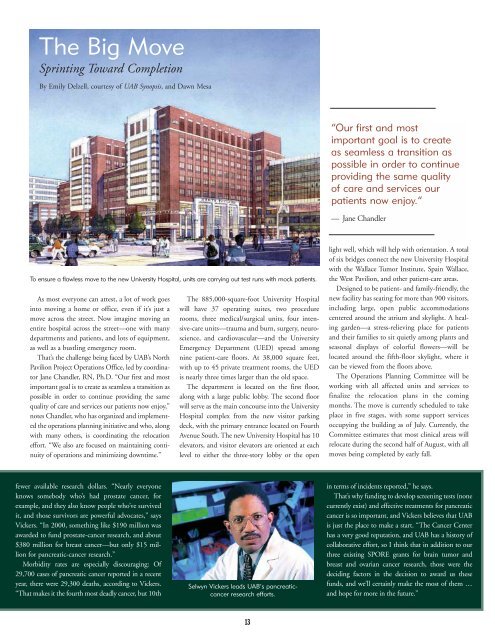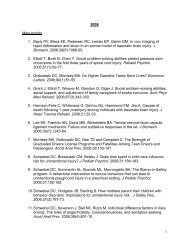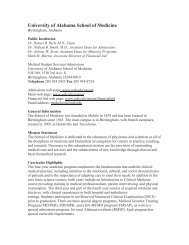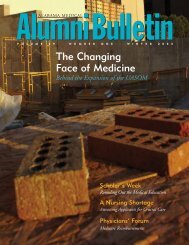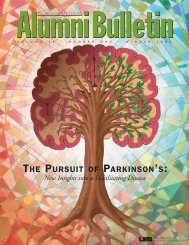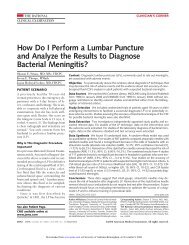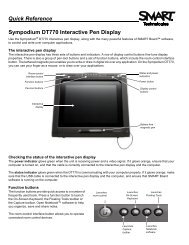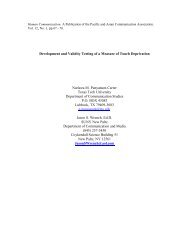uasom doctors uasom doctors - University of Alabama at Birmingham
uasom doctors uasom doctors - University of Alabama at Birmingham
uasom doctors uasom doctors - University of Alabama at Birmingham
Create successful ePaper yourself
Turn your PDF publications into a flip-book with our unique Google optimized e-Paper software.
The Big Move<br />
Sprinting Toward Completion<br />
By Emily Delzell, courtesy <strong>of</strong> UAB Synopsis, and Dawn Mesa<br />
“Our first and most<br />
important goal is to cre<strong>at</strong>e<br />
as seamless a transition as<br />
possible in order to continue<br />
providing the same quality<br />
<strong>of</strong> care and services our<br />
p<strong>at</strong>ients now enjoy.”<br />
— Jane Chandler<br />
To ensure a flawless move to the new <strong>University</strong> Hospital, units are carrying out test runs with mock p<strong>at</strong>ients.<br />
As most everyone can <strong>at</strong>test, a lot <strong>of</strong> work goes<br />
into moving a home or <strong>of</strong>fice, even if it’s just a<br />
move across the street. Now imagine moving an<br />
entire hospital across the street—one with many<br />
departments and p<strong>at</strong>ients, and lots <strong>of</strong> equipment,<br />
as well as a bustling emergency room.<br />
Th<strong>at</strong>’s the challenge being faced by UAB’s North<br />
Pavilion Project Oper<strong>at</strong>ions Office, led by coordin<strong>at</strong>or<br />
Jane Chandler, RN, Ph.D. “Our first and most<br />
important goal is to cre<strong>at</strong>e as seamless a transition as<br />
possible in order to continue providing the same<br />
quality <strong>of</strong> care and services our p<strong>at</strong>ients now enjoy,”<br />
notes Chandler, who has organized and implemented<br />
the oper<strong>at</strong>ions planning initi<strong>at</strong>ive and who, along<br />
with many others, is coordin<strong>at</strong>ing the reloc<strong>at</strong>ion<br />
effort. “We also are focused on maintaining continuity<br />
<strong>of</strong> oper<strong>at</strong>ions and minimizing downtime.”<br />
The 885,000-square-foot <strong>University</strong> Hospital<br />
will have 37 oper<strong>at</strong>ing suites, two procedure<br />
rooms, three medical/surgical units, four intensive-care<br />
units—trauma and burn, surgery, neuroscience,<br />
and cardiovascular—and the <strong>University</strong><br />
Emergency Department (UED) spread among<br />
nine p<strong>at</strong>ient-care floors. At 38,000 square feet,<br />
with up to 45 priv<strong>at</strong>e tre<strong>at</strong>ment rooms, the UED<br />
is nearly three times larger than the old space.<br />
The department is loc<strong>at</strong>ed on the first floor,<br />
along with a large public lobby. The second floor<br />
will serve as the main concourse into the <strong>University</strong><br />
Hospital complex from the new visitor parking<br />
deck, with the primary entrance loc<strong>at</strong>ed on Fourth<br />
Avenue South. The new <strong>University</strong> Hospital has 10<br />
elev<strong>at</strong>ors, and visitor elev<strong>at</strong>ors are oriented <strong>at</strong> each<br />
level to either the three-story lobby or the open<br />
light well, which will help with orient<strong>at</strong>ion. A total<br />
<strong>of</strong> six bridges connect the new <strong>University</strong> Hospital<br />
with the Wallace Tumor Institute, Spain Wallace,<br />
the West Pavilion, and other p<strong>at</strong>ient-care areas.<br />
Designed to be p<strong>at</strong>ient- and family-friendly, the<br />
new facility has se<strong>at</strong>ing for more than 900 visitors,<br />
including large, open public accommod<strong>at</strong>ions<br />
centered around the <strong>at</strong>rium and skylight. A healing<br />
garden—a stress-relieving place for p<strong>at</strong>ients<br />
and their families to sit quietly among plants and<br />
seasonal displays <strong>of</strong> colorful flowers—will be<br />
loc<strong>at</strong>ed around the fifth-floor skylight, where it<br />
can be viewed from the floors above.<br />
The Oper<strong>at</strong>ions Planning Committee will be<br />
working with all affected units and services to<br />
finalize the reloc<strong>at</strong>ion plans in the coming<br />
months. The move is currently scheduled to take<br />
place in five stages, with some support services<br />
occupying the building as <strong>of</strong> July. Currently, the<br />
Committee estim<strong>at</strong>es th<strong>at</strong> most clinical areas will<br />
reloc<strong>at</strong>e during the second half <strong>of</strong> August, with all<br />
moves being completed by early fall.<br />
fewer available research dollars. “Nearly everyone<br />
knows somebody who’s had prost<strong>at</strong>e cancer, for<br />
example, and they also know people who’ve survived<br />
it, and those survivors are powerful advoc<strong>at</strong>es,” says<br />
Vickers. “In 2000, something like $190 million was<br />
awarded to fund prost<strong>at</strong>e-cancer research, and about<br />
$380 million for breast cancer—but only $15 million<br />
for pancre<strong>at</strong>ic-cancer research.”<br />
Morbidity r<strong>at</strong>es are especially discouraging: Of<br />
29,700 cases <strong>of</strong> pancre<strong>at</strong>ic cancer reported in a recent<br />
year, there were 29,300 de<strong>at</strong>hs, according to Vickers.<br />
“Th<strong>at</strong> makes it the fourth most deadly cancer, but 10th<br />
Selwyn Vickers leads UAB’s pancre<strong>at</strong>iccancer<br />
research efforts.<br />
in terms <strong>of</strong> incidents reported,” he says.<br />
Th<strong>at</strong>’s why funding to develop screening tests (none<br />
currently exist) and effective tre<strong>at</strong>ments for pancre<strong>at</strong>ic<br />
cancer is so important, and Vickers believes th<strong>at</strong> UAB<br />
is just the place to make a start. “The Cancer Center<br />
has a very good reput<strong>at</strong>ion, and UAB has a history <strong>of</strong><br />
collabor<strong>at</strong>ive effort, so I think th<strong>at</strong> in addition to our<br />
three existing SPORE grants for brain tumor and<br />
breast and ovarian cancer research, those were the<br />
deciding factors in the decision to award us these<br />
funds, and we’ll certainly make the most <strong>of</strong> them …<br />
and hope for more in the future.”<br />
13


